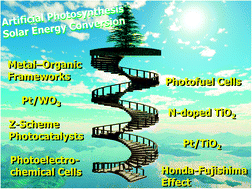Recent advances in visible-light-responsive photocatalysts for hydrogen production and solar energy conversion – from semiconducting TiO2 to MOF/PCP photocatalysts
Abstract
The present perspective describes recent advances in visible-light-responsive photocatalysts intended to develop novel and efficient solar energy conversion technologies, including water splitting and photofuel cells. Water splitting is recognized as one of the most promising techniques to convert solar energy as a clean and abundant energy resource into chemical energy in the form of hydrogen. In recent years, increasing concern is directed to not only the development of new photocatalytic materials but also the importance of technologies to produce hydrogen and oxygen separately. Photofuel cells can convert solar energy into electrical energy by decomposing bio-related compounds and livestock waste as fuels. The advances of photocatalysts enabling these solar energy conversion technologies have been going on since the discovery of semiconducting titanium dioxide materials and have extended to organic–inorganic hybrid materials, such as metal–organic frameworks and porous coordination polymers (MOF/PCP).

- This article is part of the themed collection: Physical chemistry at the cross-road of advanced oxide materials

 Please wait while we load your content...
Please wait while we load your content...